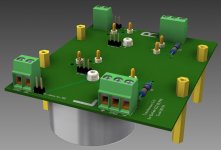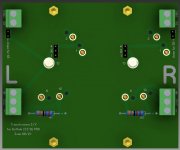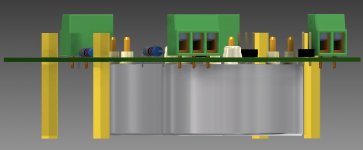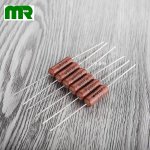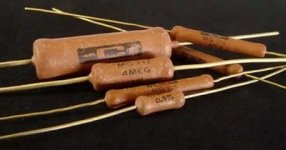I have not purchased copper pillars, but I expect to purchase a variety of specifications, and they can be connected to each other to increase the length, so I think the specifications of the copper pillars are not a problem. The transformers are installed on the back of the PCB board, so won't the vibration caused by the transformer be a problem?
What specifications are recommended for resistors?
What specifications are recommended for resistors?
What transformer? Power transformer or what? Anyway, no matter as there is no difference how to mount, top or bottom. The central (13/shielding) pad should be tighted through PCB by M3 screw with split lock (spring) washer:so won't the vibration caused by the transformer be a problem?
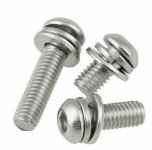
So it will be fixed very well even using the receptacles.
What specifications are recommended for resistors?
Various material types of resistors used for audio circuits are OK. The value of resistors are high enough to avoid the special brands. Try 2kOhm.
No, I just thought it would be useful for other Buffalo users to know the loading resistor value, to be at the same output level (say for 50k input impedanced next stage) like for Mercury, to make my transformer's output the same in terms of the output level. OK.
BTW, what the input sensetivity is chosen now in your AHB2?
Low-Gain, Mid-Gain, or High-Gain
BTW, what the input sensetivity is chosen now in your AHB2?
Low-Gain, Mid-Gain, or High-Gain
What is the advantage of the jfet powered buffer over passive transformer output? Do you have a balanced version (would that require double the power input)?
I do like how I can eliminate transformers and related power supplies that were previously used to power my balanced output stage.
I do like how I can eliminate transformers and related power supplies that were previously used to power my balanced output stage.
Here is the version of PCB using jfet buffers. SE output ONLY.
View attachment 959101
View attachment 959102
Some tips:
1) To have quick access to both PCB sides (for jumpers re-settings, components resolderings, etc.) it is better to have possibility of transformers dismounting using the receptacles:
5391-0-15-15-07-27-10-0 Mill-Max | Mouser Europe
2) M3 spacers 4mm in height for proper gap between PCB components and transformer plate will be needed to place as well.
3) Better to use a matched pair of 2SK170V/2SJ74V (output impedance better, no offset) instead of using the trimmer between transistors Sources (for set zero output offset).
4) For better thermal/current simmetry stability it is better to tight this pair of transistors together using a copper foil and/or small radiator.
5) The PSU quality is VERY important. Based on my experience I highly recommend to use UCs or/and battery PSU for powering jfets.
All the corresponding files (CAD, gerbers) can be found here:
View attachment 959103
I think 1k on the output transformers is close to the Mercury output with the 9038-specific resistors (I don't have the value in front of me).
I'm using the lowest gain setting on AHB2 and get plenty of volume play using the 9038 volume control.
I'm using the lowest gain setting on AHB2 and get plenty of volume play using the 9038 volume control.
No, I just thought it would be useful for other Buffalo users to know the loading resistor value, to be at the same output level (say for 50k input impedanced next stage) like for Mercury, to make my transformer's output the same in terms of the output level. OK.
BTW, what the input sensetivity is chosen now in your AHB2?
Low-Gain, Mid-Gain, or High-Gain
What is the advantage of the jfet powered buffer over passive transformer output? Do you have a balanced version (would that require double the power input)?
I do like how I can eliminate transformers and related power supplies that were previously used to power my balanced output stage.
Balanced version is under development...
It is more about weak DACs from the past with its 1/2/4mA of the output signal rather than about 38PRO with its huge 60mA... But, answering to your question in generalized manner:
Advantage is the increased power of the signal, expressed as a decrease in the output impedance. But it will have not a big advantage effect if to use a highly-impedance input next stage Amplifier/Preamplifier as you simply can't grab all the signal current over the high input impedance of your Amp/Preamp. Of course if someone really wants to get benifits from the buffered version over the non-buffered, needs to use low-impedanced line (600 Ohm or lower input impedance of the next stage Amp/Preamp)
BTW, most of the brands, who uses step-up transformers in their DACs, simply wan't to have a problems with connection to low-impedanced amplifiers and installs the active circuits to the outputs to ensure the same output signal level within the wide loading range. If I will be a pricy brand I will prefer to use similar approach, but as we are in DIY area, I just can ask customer regarding his amp/preamp before the order. But again, it is more relates to the weak DACs, 38PRO is a bit another story as the output impedance after transformer is low enough even at 2-3-4V swing for the wide range of Amps/Preamps.
Last edited:
Thanks.I think 1k on the output transformers is close to the Mercury output with the 9038-specific resistors (I don't have the value in front of me).
I'm using the lowest gain setting on AHB2 and get plenty of volume play using the 9038 volume control.
In this case I recommend you to increase both the loading resistor to 2k and the input sensitivity of your AHB2 to Mid-Gain. Should sounds better
I will try. I had assumed lower gain on the AHB2 would be better. What will the resistor change do to the sound beyond gain?
The issue I have been trying to solve for with my DAC, amp and speaker combo is that the system can be overly bright. My speakers are 3-way bookshelves with ribbon tweeters. They are very resolving and have strong, transparent low-end but many of the output stages I've tried are too bright with the buffalo dac.
Power supplies and ultracaps have made a difference - the biggest probably being moving to a LT3045 power supply on the DAC - bass was much more defined and stronger. Adding Sparkos discrete volatge regulators on the AVCC lines helped smooth things out a bit as well.
The issue I have been trying to solve for with my DAC, amp and speaker combo is that the system can be overly bright. My speakers are 3-way bookshelves with ribbon tweeters. They are very resolving and have strong, transparent low-end but many of the output stages I've tried are too bright with the buffalo dac.
Power supplies and ultracaps have made a difference - the biggest probably being moving to a LT3045 power supply on the DAC - bass was much more defined and stronger. Adding Sparkos discrete volatge regulators on the AVCC lines helped smooth things out a bit as well.
@stew1234,
I am entrusting the factory to make the PCB board for Buffalo designed by bisesik. I will get ten pieces, so I can share it with you for free. You only need to pay the postage of US$20. If you are interested, you can tell me.
Thank you for the offer yunyun. I will think about it. The stock might be too high given the case I have planned but will see.
Also, where did you order the thick u.fl cables you are using?
Sorry, I misunderstood and thought that you have the highest gain mode (I was guided by the description of 2VI will try. I had assumed lower gain on the AHB2 would be better. What will the resistor change do to the sound beyond gain?
- Home
- Vendor's Bazaar
- Output transformers for DACs
